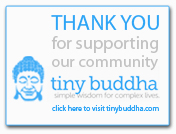Brushes with Mortality: 5 Lessons On Dealing with Hard Times
 This article has been reprinted with permission by the author. It originally appeared on the Tiny Buddha website.
This article has been reprinted with permission by the author. It originally appeared on the Tiny Buddha website.
by Rachel Katz
“When we come close to those things that break us down, we touch those things that also break us open. And in that breaking open, we uncover our true nature.” ~Wayne Muller
As someone with a serious chronic medical condition, I have danced with mortality. Many times. It wasn’t until our most recent pas de deux, however, that I truly understood just how much this dance could impact me.
Nowhere was this more apparent than in my work as a hospice volunteer.
The mission of the San Francisco-based Zen Hospice Project—a Buddhist-inspired organization where I have volunteered for five years—is to bring kindness and compassion to those facing loss and death.
I trained to be a volunteer out of a deep longing to explore and evolve my comfort level with my own illness and mortality, as well as the mortality of those close to me.
Zen Hospice Project trains volunteers to practice the Five Precepts Of Hospice Care developed by its founder.
They are:
1. Bring your whole self to the bedside.
2. Welcome everything; push away nothing.
3. Find a place of rest in the middle of things.
4. Cultivate the “don’t know mind.”
5. Don’t wait.
While I have attempted to integrate these precepts at bedside (and in my life in general), I am also aware that I have remained somewhat disconnected from them.
For example, though I have always been able to easily listen with compassion as patients and family members voiced their feelings about dying; to hold a hand; provide a gentle foot massage; bring hot tea and fresh flowers; and sing to patients, I could not (or more aptly did not want to) fully feel the devastating grief that accompanies loss.
Until, that is, I returned to hospice work last year after undergoing emergency brain surgery.
Some background: As a child, I was diagnosed with a neurological condition called hydrocephalus that prevents the cerebrospinal fluid from circulating correctly in my brain. As such, a device called a shunt lives in my brain’s ventricles, keeping the fluid circulating properly.
I had my initial shunt inserted at twelve years old and have had my share of shunt revisions, the last occurring twenty years ago.
But on a clear, crisp day last April, I was starkly reminded of my medical issue when, with little warning, my shunt malfunctioned and I was rushed to the hospital in excruciating pain and told I would need immediate surgery to revise the apparatus.
Despite knowing that I always bounce back from surgeries, and despite my training and practice as an end-of-life volunteer, I felt little solace. The fact was I might not wake up. I did not want to die.
I did wake up and within three days, was back home recovering. My nurse practitioner commented that I was “the poster child for healing” because of my tenacity, positive attitude, and fit body (a stellar medical team and sheer luck no doubt also played a part).
When I returned to hospice work only a few months post-surgery, I noticed a subtle yet powerful internal energetic shift.
My 2.0 body and spirit felt much more integrated. Whatever disconnection I had previously felt bedside had dissolved and was replaced with an intimacy that can only develop out of shared experience.
It quickly became clear that my brush with mortality had unlocked the door to a richer, more meaningful and transparent connection with the precepts, the patients, and myself.
While I am still integrating all that has happened, I’ve come to understand the following about the five hospice precepts as they relate to me—and possibly, to others facing health or other challenges.
1. Bring your whole self to the bedside.
If patients share something that I have also been through, I now give myself permission to tell them a bit of my own health story—how it felt to be stuck in a bed, feeling like my body was failing me, existentially alone and angry. This almost always allows for a more intimate connection.
For so many years I felt ashamed of my condition. Would people unfairly judge me for having a brain-related condition? Would people think I am “less than”? I owe it to myself to show up more honestly. My condition is just a part of the fabric of who I am, all threads woven together.
Sometimes, revealing some of our own messiness, our own fallibility, can bring us much closer to others.
2. Welcome everything; push away nothing.
We can’t always choose our circumstances. Sometimes they choose us. My condition is chronic. While this can feel unfair and overwhelming at times, I have come to welcome everything and push away nothing that shows up in my life.
There are times when I drop to my knees, sobbing, terrified, and rageful at the possibility of more surgeries and their physical and emotional aftermath. I also accept that I am not always able to gracefully befriend the raw envy that I sometimes feel witnessing those with radiant health, especially when, from my perspective, some seem to so easily take it for granted.
Welcoming everything tenderizes me to my own and others’ suffering. And joy. I now see that by welcoming everything (or at least attempting to whenever I can), I am living life more wholeheartedly, even when the challenges feel daunting.
3. Find a place of rest in the middle of things.
Serving as a hospice volunteer I can offer warmth and compassion, but as much as I might want to, I cannot fix another’s circumstances.
My ability to serve at bedside and beyond depends upon holding that distinction. I know that no one can take away my own fears about having a life-threatening condition. But it sure helps to remind myself that I am not the only one who goes through life feeling fear and uncertainty.
4. Cultivate the “don’t know mind.”
While I used to crave answers to why things happen as they do, I am now cultivating a deeper sense of wonder, curiosity, and surrender to life’s mysteries. One can never truly know what’s going on inside another’s head, heart, and body, nor do any of us know exactly what our own future holds or when we will be saying our final goodbyes.
We can only stay present, respond to what arises in each moment, and act from the most genuine place.
5. Don’t wait.
If we are aware, pay attention, and do our best in this moment—fully, passionately, and courageously—that is what truly matters.
While at first I was angry and distraught that I had to dance with mortality yet again, the experience ended up being a great teacher and transformational gift. Yes, I’m still learning to dance, and perhaps I never will totally “get it right.”
Since my surgery I approach the Five Precepts of Hospice Care much more wholeheartedly. No longer are they simply intellectual guideposts but rather a dynamic life force within me.
It is possible for us all to make the choice, moment by moment, to be fully here and not move away from the difficult feelings.
And when we do want to escape the moment, we can sit down, close our eyes, ground our feet firmly on the floor, take slow, deep breaths, and when our body, mind, and soul feel calm and focused, softly whisper “yes!”

